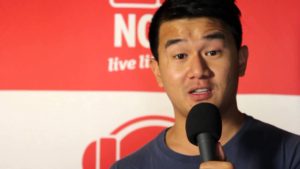Diversity not reflected in TV drama, study finds
Australian television drama is failing to portray people from culturally diverse groups in its representations of the wider society, a new survey has found.
While indigenous characters are now featuring prominently on the small screen, people from non-Anglo Celtic backgrounds and those identifying as LGBTQI are not.
A Screen Australia survey of all 199 dramas aired on Australian television between 2011 and 2015 examined almost two thousand “main” characters appearing in TV shows.

Ronny Chieng
Its aim was to track visible diversity, as viewers see it, in terms of a character’s sexuality, disability or cultural background.
The survey, titled. ‘Seeing ourselves: Reflections on diversity in Australian TV drama’, found that although around 32 per cent of Australians have a cultural background other than Anglo-Celtic only 18 per cent of main characters had non-Anglo-Celtic backgrounds.
About 11 per cent of Australians identify as LGBTQI, but the survey found just 5 per cent of TV drama characters are non-straight.
The majority of these were gay men, followed by lesbian women. Transgender or intersex characters were largely absent.
However, children’s shows were much more diverse than those made for adults, the survey found.
Thirteen out of 25 children’s programs have main or recurring characters of non-European background.
Most of those characters are visibly non-European, rather than being identified through a story line – which the report’s authors says helps normalise diversity on our screens.
Comedy shows also had more non-Anglo-Celtic characters than dramas, but much of the diversity comes from just a few programs.
Two shows “Maximum Choppage’ and ‘Jonah from Tonga’ accounted for about a third of all non-European actors across all 51 comedy shows included in the survey.
Comedian Ronny Chieng was in six comedies across five years.
Surprisingly, indigenous characters surprisingly featured as a larger proportion than the indigenous representation in Australian society.
Currently, five per cent of all main characters on TV are indigenous, while indigenous people make up just three per cent of Australia’s population.
People with a disability had the lowest rate of representation. Around 18 per cent of Australians have a disability while just 4 per cent of surveyed characters were identified as disabled.
The study cited online productions – which are cheaper and less risky – as evidence that audiences exist for niche characters and stories.
It said the prevalence of much greater diversity in advertising shows there’s a commercial argument for connecting with these audiences.
Screen Australia used four cultural diversity categories created by the Australian Human Rights Commission, which broadly reflect historical immigration trends: Anglo-Celtic, European, Non-European and Indigenous.
Definitions of sexuality and disability were taken from the Sex Discrimination Act and the Disability Discrimination Act respectively.
Laurie Nowell
AMES Australia Senior Journalist












